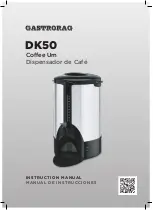
Page 2 of 7
Prepared January, 2 2018
Silicosis may be progressive; it may lead to disability and death.
Cancer:
Crystalline silica (quartz) inhaled from occupational sources is classified as carcinogenic to
humans.
Autoimmune Diseases:
There are some studies that show excess numbers of cases of scleroderma and
other connective tissue disorders in workers exposed to respirable crystalline silica.
Tuberculosis:
Silicosis increase the risk of tuberculosis.
Nephrotoxicity
: There are some studies that show an increased incidence of chronic kidney disease and
end-stage renal disease in workers exposed to respirable crystalline silica.
Eye Contact:
Crystalline silica (quartz) may cause abrasion of the cornea.
Skin Contact:
Not applicable
Ingestion:
Not applicable
Chronic Effects:
The adverse health effects-silicosis, cancer, autoimmune diseases, tuberculosis, and
nephrotoxicity-are chronic effects.
Signs and Symptoms of Exposure:
Generally, there are no signs or symptoms of exposure to crystalline
silica
(quartz).
Medical Conditions Generally Aggravated by Exposure:
The condition of individuals with lung disease
(e.g., bronchitis, emphysema, chronic obstructive pulmonary disease) can be aggravated by
exposure. See section 11, Toxicological Information, for additional detail on potential adverse
health
effects.
IV. FIRST AID MEASURES
Symptoms of Overexposure:
Inhaled:
Shortness of breath, coughing, reduced pulmonary function. Prolonged inhalation of repsirable
silica may result in permanent lung damage, silicosis. No specific first aid is necessary since the
adverse health effects associated with exposure to crystalline silica (quartz) result from chronic
exposures. If there is a gross inhalation of crystalline silica (quartz), remove the person
immediately to fresh air, give artificial respiration as needed, seek medical attention as needed.
Swallowed:
May cause gastrointestinal discomfort. Give one or two glasses of water. If discomfort
persists,
see
a
physician.
First Aid:
Emergency procedures.
Eye Contact:
Wash with water for at least fifteen (15) minutes. If irritation or redness persists see a
physician.
Skin Contact:
Wash with soap and water. If irritation persists see a physician.
Ingestion:
Not applicable.
Suspected Cancer Agent:
Yes
Federal OSHA:
No
NTP:
Yes
IARC:
Yes
NTP:
Respirable crystalline silica has been listed in the Sixth Annual Report on Carcinogens.
IARC:
Monographs on the Evaluation of the Carcinogenic Risk of Chemical to Humans (vol. 68, 1997)
concludes that there is sufficient evidence in humans for the carcinogenicity of inhaled crystalline
silica in the forms of quartz and cristobalite (Group 1) in certain industrial circumstances, but that
carinogenicity may be dependent on inherent characteristics of the crystalline silica or on external
factors affecting is biological activity or distribution of its polymorphs.
V. FIRE FIGHTING MEASURES
Crystalline silica (quartz) is not flammable, combustible, or explosive.
VI. ACCIDENTAL RELEASE MEASURES
Spill Response Procedures (including employee protection measures):
Clean up using approved, dustless
methods (water or vacuum) to minimize generation of respirable silica particles.
Waste Disposal:
Dispose of in a facility approved for silica (also see Section 13).
10
Содержание CW330 Series
Страница 1: ...Rev 6 07 High Efficiency Sand Filters CW330 Series...
Страница 21: ...18 6 07 2 4 Startup Data Sheet...
Страница 22: ...19 6 07 2 5 Filter Log Sheet...
Страница 31: ...28 6 07...
Страница 36: ...CP Control Panel Enclosure with Labeled Components...
Страница 37: ......
Страница 38: ...TBIO Input output strips on Terminal block labeled to indicate connection points...
Страница 39: ......
Страница 40: ......
Страница 41: ...38 CPIO Input output strips on PLC labeled to indicate connection points...
Страница 43: ......
Страница 45: ...42 6 System Component Cut Sheets...














































